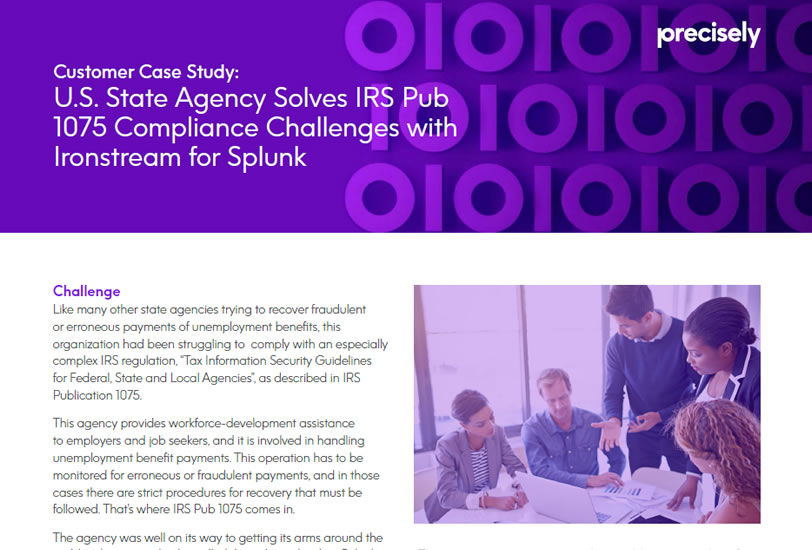INDUSTRY SOLUTIONS
Government solutions
Empowering the government sector to gain a stronger understanding of constituents, boost data governance strategy, capitalize on critical funding opportunities, and modernize processes to bridge the gap between existing and emerging technologies.
Solutions powered by trusted data are the fuel for a smarter, more transparent, and efficient government.
Help your agency move faster, govern smarter, and direct funding where it’s needed most.

Government
- Boost process efficiency across government agencies through modernization initiatives
- Make better, faster decisions based on a strong data governance strategy
- Better utilize government resources and fund agency programs that are needed the most
Government’s
data-driven digital transformation
Government is at the heart of our daily lives. It holds the ability to transform the way that we live and work – and in fact, this sector is undergoing a data-driven transformation of its own.
Advancing the use of data is key to modernizing day-to-day operations and improving citizen services across the full range of government activities.
Government agencies that aren’t keeping pace with our changing digital landscape will find it difficult to meet strategic objectives and satisfy the changing needs of the public at large. Not to mention, sub-optimal processes can lead to compliance issues and costly fines along the way.
Each agency is at a different point in their journey to digital transformation. Whether their priorities are moving from antiquated mainframes to the cloud, creating a data governance framework, leveraging spatial insights, or anything in between, the goal is to empower confident data-driven decisions that fundamentally improve the lives of the constituents they serve.
Achieving key objectives for government means ensuring access to critical resources and providing impeccable service for those who need it the most. For government, data analytics and management solutions enable agencies to achieve and exceed these goals to truly make an impact.
Our government solutions include:
Data Integration

Data Governance
Location Insights
Data Integrity

Data Enrichment
360 Citizen View
Boost data modernization initatives and eliminate data silos
Unlock the data potential for agile, scalable government processes
Outdated mainframe processes are holding government agencies back from optimizing time-consuming everyday tasks and capitalizing on lucrative funding opportunities.
Modernizing everyday services with automation and moving to the cloud alleviates hefty infrastructure costs and opens the door to new levels of accuracy, information, and insight. The key? Context – an essential component of data integrity.
Address management is a prime example of an area where the context makes all the difference. Think about the copious amount of time that government sector agencies spend on planning for fund disbursement, targeted constituent services, public transportation improvements, and more – all these varied areas share a common need for addresses that are contextualized.
Utilizing access to spatial insights gives agencies the full scope of information needed to make informed, accurate decisions – ensuring that funds are correctly distributed, and constituents are properly informed about where they can receive the services they need.
And with $1 billion budgeted for data modernization in the federal government, the demand for data with integrity – delivering accuracy, consistency, and context – has never been stronger.
Every federal agency can apply for these funds, but if their data is missing, inaccessible, or lacking in quality, many will simply be ineligible to qualify. For these agencies in the government, solutions are needed to make sure that they’re not leaving millions of dollars on the table.
Gaining visibility across data siloes is also crucial to achieving a 360-degree view of government IT infrastructure. Ironstream™ software delivers mission-critical data, events, and intelligence from both IBM mainframe and IBM i environments and makes them work seamlessly with Splunk, ServiceNow, Micro Focus, Elastic and more.
Modernization that endures requires a holistic approach to technology design, development, and deployment. Make the most of your legacy data with trusted government solutions.

Resources
Improve inter-agency communication through enhanced data governance
A strong governance framework for better decisions across government
The government sector is inundated with data, but many agencies lack a solid data governance foundation – if they even have one at all.
With these disparate datasets consistently coming in and making their way through the various hubs of an organization’s processing pipeline, the information can quickly become complicated and inconsistent.
Take, for example, low-quality data that gets cleaned up in one area of operations. Without the appropriate policies and procedures in place, those optimizations are never made back at the source system, which has a completely different owner. How can you be sure which data is complete and reliable to use? Government workers need to be able to find, understand, and trust their data.
That’s where data governance comes in.
At its core, a comprehensive data governance program aims to drive better decisions that produce stronger outcomes based on trusted data. Without it, agencies in the public sector lack the confidence required to maximize their data to its fullest potential, and therefore miss valuable opportunities to accurately target their services to those who need it most.
To truly thrive, collaborate, and meet key strategic objectives, users need a solution that automates governance and stewardship tasks, and ensures the quality, value, and trustworthiness of their data – in addition to gaining a fuller understand the data’s source, use, meaning, ownership, and quality.
Data governance is no small task – embark on a journey of building comprehensive data governance programs that last.
Broward County Public Schools keep students, families and teachers informed in real time
When the Broward County Public Schools data warehouse was first started in 1996, the vision was to make a significant difference in student achievement with data. This vision became a reality as Broward County began to empower thousands of non-technical users with information from its data warehouse.
„Connect helps keep our students and their families informed in real-time and enables our teachers and administrators to perform faster, better data analysis.”
– Phyllis Chasser, Ph.D.
Senior Data Warehouse Analyst, Broward County Public Schools
Maximize broadband funding and achieve digital equity
Access to critical government services for every constituent
In the digital era, internet access is no longer a “nice-to-have” bonus – it’s ingrained in our daily lives. But while the number of citizens with access to computers and the internet continues to grow exponentially, so does the digital divide.
Constituents need access to critical government services, such as health care, education, police protection, and welfare programs to receive much-needed government support on a timely basis. Yet, the gaps in broadband coverage in unserved and underserved communities create substantial barriers to communication and create greater digital inequality.
State and local governments are actively pursuing federal funding programs to close these gaps. Broadband mapping is crucial here, but it’s often overlooked and fueled by poor quality data – leading to inaccurate decisions that don’t truly benefit those who need it the most.
To really provide fair and equitable broadband access, you need data with integrity and context, enabling you to build the most comprehensive view of properties and support new government connectivity programs.
It starts with the most current and extensive list of all known addresses containing high-precision locations of each building point, mail delivery indicators, detailed land use information, and building designations.
Accurate addresses are extremely important, but often not sufficient enough to get the most comprehensive picture you can provide every constituent with access to vital government services.
Diving deeper with the ability to identify complex relationships between property features and addresses to identify serviceable locations, even when they are located within multi-dwelling or multi-tenant units, is what enables you to make a real impact.

Resources
Drive better constituent services with a 360° view
Iterative approach to gain deeper insights and context
With all the hustle and bustle of everyday life, time is valuable and digital experiences are held to an increasingly high – and tailored – standard. The government sector is no exception.
When constituents visit a government website, their experience needs to be seamless. For instance, discovering their eligibility for federal social assistance programs should be simple and confusion-free. And in local government, software solutions are becoming more in demand as constituents increasingly expect to interact in a personalized, interactive, and immediate way.
To meet this demand, governments need to fully understand each individual’s unique situation and needs – that means breaking down the barriers built by legacy IT systems, multiple databases, and conflicting data formats, and instead achieving a single, powerful 360° view of the citizen.
This public sector solution enables organizations to keep up with demand from citizens seeking information while supporting and addressing potential data quality issues that often result in increased costs and decreased satisfaction scores.
Through improved data quality and a single view of the citizen, governments can ensure more impactful resource allocation, better quality services, and a happier, more engaged public.
In short: better constituent services begin with better connections.
The most critical citizen insights are hiding in your data. Make an impact with a true 360° view.

Resources
Improve accuracy with a data-driven approach
Around the world, government organizations are increasingly challenged with how best to modernize their data processes to increase internal efficiencies and improve public services.
In the government sector, gaining data-driven analytics and insights to improve the lives of citizens is a critical objective – one that will continue to depend on data with integrity.
Agencies that prioritize modernization initiatives and govern their data properly will be the ones that thrive, producing more accurate data that drives continued positive change in our communities.
Precisely Achieves FedRAMP® In Process Status for its Data Integrity Suite Data Governance Service
Precisely is an approved supplier under the Crown Commercial Service’s G-Cloud 13 Framework
IOur customers in central government, local government, and public sector organizations across the UK can easily access our portfolio of data integrity solutions to power confident decision-making.
U.S. State agency solves IRS Pub 1075 compliance challenges with Ironstream™ software for Splunk®
Like many other state agencies trying to recover fraudulent or erroneous payments of unemployment benefits, this organization had been struggling to comply with an especially complex IRS regulation, “Tax Information Security Guidelines for Federal, State and Local Agencies,” as described in IRS Publication 1075.
This agency provides workforce-development assistance to employers and job seekers, and it is involved in handling unemployment benefit payments. This operation must be monitored for erroneous or fraudulent payments, and in those cases, there are strict procedures for recovery that must be followed. Learn how Ironstream for Splunk helped recover lost payments while staying in compliance with complex regulations.



